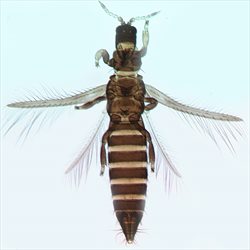
Female
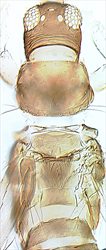
Head & thorax
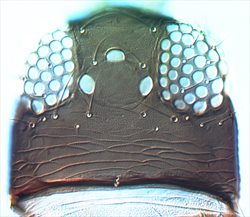
Head

Antenna
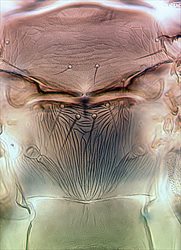
Meso & metanota
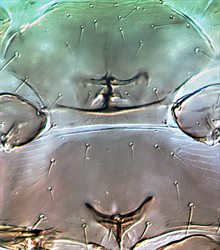
Meso & metathoracic furcae
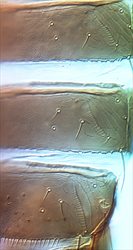
Tergites VI–VIII

Male sternites IV–VII
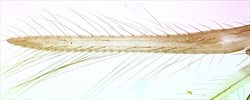
Fore wing
Both sexes fully winged. Body brown to dark brown, tarsi and fore tibiae paler; antennal segments III and apex of II yellow, IV light brown, V–VII brown; fore wings evenly light brown, clavus darker. Antennae 7-segmented, III–IV each with short forked sense cone. Head about as long as wide or slightly longer, without sculpture between ocelli; 2 pairs of ocellar setae, pair II longer than pair III that arise just anterior to hind ocelli; postocular setae variable, pairs I and III usually as long as distance between hind ocelli, but one or both setae of pair I commonly absent; pair II short and arising behind this row of setae. Pronotum with 2 pairs of long posteroangular setae; posterior margin with 2–3 pairs of setae. Metanotum longitudinally striate, striae converging posteromedially; campaniform sensilla absent, median setae arise behind anterior margin. Mesofurca without spinula. Fore wing first vein with 2–4 setae on distal half; second vein with complete row of about 12 setae. Tergites II–VIII with no sculpture medially, median setae small, wide apart; V–VIII with paired ctenidia laterally, on VIII posteromesad to spiracle; posteromarginal comb complete with irregular slender microtrichia. Sternites without discal setae, posterior margins with irregular, small dentate microtrichia; sternites IV–VI sometimes with small and poorly developed pore plate medially; setae S1 on sternite VII arising just in front of margin.
Male similar to female but smaller; tergites II–VII posterior margin with small, laterally pointing teeth, VIII with similar teeth arranged irregularly; sternites frequently bearing many discal microtrichia, posterior margins with irregular dentate microtrichia, III–VII with transverse pore plate.
The genus Stenchaetothrips currently includes 42 species, all associated with Poaceae and all originally from the Old World tropics, particularly Southeast Asia. The genus represents a radiation onto grasses derived from the genus Thrips. A suggestion that specimens of S. biformis from Europe on Phragmites can be distinguished from specimens on rice (Vierbergen, 2004) has been discussed and refuted (Mound, 2011b); there is considerable variation in the presence and length of the postocular setae within individual samples of biformis from Asia.
The Oriental Rice Thrips lives on the leaves of various Poaceae in damp places in the tropics, and in England has been taken from Phragmites and Phalaris.
Described originally from Oxfordshire (Bagnall, 1913b), this species had otherwise been collected outdoors in Britain only from a couple of sites to the west of London, and one in southern Kent (Mound et al., 1976 as Baliothrips biformis). However, single adults have recently been taken at two sites in Yorkshire (Collins, 2011) suggesting the species may be more widely distributed, but only locally common and so overlooked. Known as a pest of seedling rice in Asia, the Oriental Rice Thrips has been recorded from eastern Europe, and across Asia from Iran to northern Australia. It has also been introduced into South America.
THRIPIDAE - THRIPINAE
Stenchaetothrips biformis (Bagnall)
Bagnallia biformis Bagnall, 1913: 237
Bagnallia biformis f. adusta Bagnall, 1913: 238
Bagnallia melanurus Bagnall, 1913: 238
Thrips (Bagnallia) oryzae Williams, 1916: 353
Thrips holorphnus Karny, 1925: 15
Plesiothrips o Girault, 1929: 1
Thrips dobrogensis Knechtel, 1964: 479
Chloethrips blandus zur Strassen, 1975: 78
Bagnall RS (1913b) Further notes on new and rare British Thysanoptera (Terebrantia) with descriptions of new species. Journal of Economic Biology 8: 231–240.
Collins DW (2011) The Thysanoptera of Thorne and Hatfield Moors. Thorne and Hatfield Moors Papers 8: 79–85.
Mound LA (2011b) Grass-dependent Thysanoptera of the family Thripidae from Australia. Zootaxa 3064: 1–40.
Mound LA, Morison GD, Pitkin BR & Palmer JM (1976) Thysanoptera. Handbooks for the Identification of British Insects 1 (11): 1–79.
Vierbergen G (2004) Eight species of thrips new for the Netherlands and some taxonomical changes in Stenchaetothrips, Thrips and Hoplothrips. Acta Phytopathologica et Entomologica Hungarica 39: 199–209.